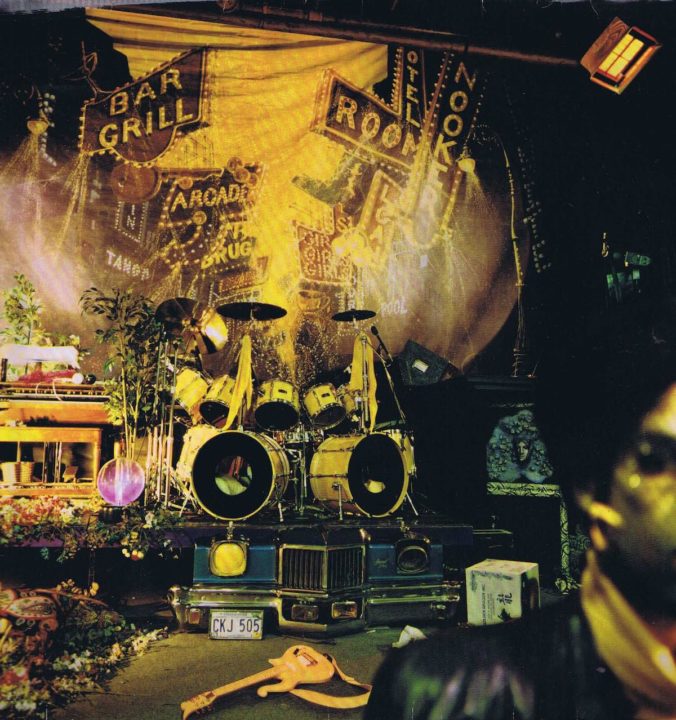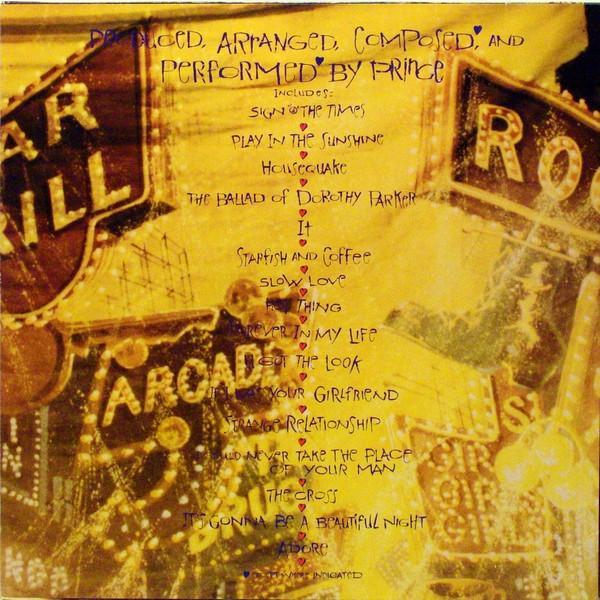After disbanding The Revolution in 1986, Prince returned as a one-man-band with a double album – Sign O’ The Times – bristling with ideas, experimentation, eclecticism and superb musicianship, which saw him cement his position as the most original voice(s) in music…

Prince’s Sign O’ The Times cover
Sartorially, Sign O’ The Times, Prince’s 1987 magnum opus, may have been coloured peach and black, but sonically it drew from a myriad hues, presented as an alchemised collage of funk, soul, electro, gospel and R&B.
Although it was less than three years after the globe-conquering juggernaut that was Purple Rain, his commercial stock had dipped significantly following two underperforming albums, both of which veered him away from the pulsing electro-rock and soaring anthems of that album, in favour of the psychedelic pop of Around The World In A Day and Eurocentric, jazz-inflected funk of Parade.
“They told him no, which was something that hadn’t really happened up ‘til that point,” Susan Rogers, Prince’s sound engineer between 1983 and 1987, told Curtain Call. “After all, they’d agreed to let him write and produce his own music from the beginning and to go off and make a movie when he was 23 and not really big yet; they pretty much let him do as he pleased but said no to the triple album idea.”
It was argued that the Around The World In A Day and Parade albums hadn’t sold that well, comparatively, with the label believing that he’d peaked commercially with Purple Rain. Consequently, Warners were reluctant to back the ambitious, and costly, Crystal Ball.
The wealth of material crafted during one of his most prolific periods was the distillation of a number of different projects. As well as writing for other artists such as The Family, The Time, Sheila E and Jill Jones, Prince was working on a jazz project with Miles Davis and had almost completed Dream Factory, a double album with The Revolution whilst on the Parade tour.
After hours, he had also begun an experimental solo project, Camille, on which he sped up his voice to give it an androgynous timbre, therefore allowing him to perform material from both a male and female perspective.
Overflowing with creativity, Prince relished the sense of liberation he experienced from those sessions on which he worked alone and made the decision to disband The Revolution at the end of the tour, keen to make a clean break and re-establish himself as a solo artist.
Aside from the split of his band, Prince was also wounded at the time by the end of his engagement to fiancée Susannah Melvoin – the twin sister of The Revolution’s bassist Wendy (the break-up with Susannah was thought by many to be the catalyst for the end of The Revolution due to the expected awkwardness between Prince and Wendy).
Finding himself without his band and without his fiancée, Prince welcomed work as a distraction, escalating his already manic workaholism. Creating almost exclusively in solitude, Susan Rogers was one of the handful of people to sit in on the sessions.
“He had to have his privacy,” Susan told Red Bull Music Academy. “He had to be completely alone. We did NOT have visitors in the studio. He needed his people around him, the people that he knew well and that he could feel comfortable with – during that time I was one of them. I knew how he liked to work, I could be quiet, I was his facilitator of recording, and I made that happen. He [required] everything there and set up ahead of time because he wanted to be able to move from instrument to instrument.”
 Prince: Sign O’ The Times – The Songs
Prince: Sign O’ The Times – The Songs
01 Sign O’ The Times
With its sparse-sounding, stripped-back beat and isolated vocal, the title track shares a sonic identity with earlier triumph When Doves Cry from the Purple Rain soundtrack. Boasting a lyric that tackles social issues such as AIDS, gun control, drug addiction and poverty, Prince’s use of street slang and vocal delivery saw him present his unique take on hip-hop. The single release also provoked controversy due to its cover image featuring a figure in a mini dress with the face obscured by a heart which some people thought was Prince cross-dressing. It was later revealed to be dancer Cat Glover.
02 Play In The Sunshine
Recorded in November 1986 on the final recording session with Prince’s ex-fiancée Susannah Melvoin, the psychedelic party-jam evokes earlier tracks such as Let’s Go Crazy and Delirious with their frenetic processed Linn drum track and rousing chorus.
03 Housequake
The album’s first taste of Prince’s androgynous alter-ego Camille (inspired by 19th-century intersex memoirist Herculine Barbin, whose nickname was Camille), Housequake sees Prince in full-on James Brown mode curating an irresistible funky throwdown which would be a highlight not only of the album but also of his live act.
04 The Ballad Of Dorothy Parker
Nothing to do with the iconic writer – Prince just liked the name. The song was inspired by a dream he had about a waitress seducing him with the promise of taking a bath together. Prince was so inspired to lay the track down he recorded it using his new drum machine before it was properly installed, giving it a muffled sound. He also decided to keep the fault on the final recording feeling it added to the song’s hazy, dream-like feel.
05 It
Cascading synths and crashing drums provide the backdrop to a sexually-charged track in which Prince boasts that he “thinks about it all the time and wants to do it all night long”. Musically, the instrumentation predates the sound that former bandmates Jam & Lewis would pioneer with Janet Jackson on Rhythm Nation.
06 Starfish and Coffee
A charming song with a nursery rhyme quality co-written and performed with Susannah Melvoin about Cynthia Rose, an eccentric girl Susannah and Wendy went to school with. The unique drum sound was achieved by recording the drums and then playing them backwards on the final track.
07 Slow Love
Slow Love was written years earlier and retrieved from the vault before being reworked as a 50s-style R&B jam, complete with brass section, finding Prince in full-on crooner mode. The track was co-written by actress/model/singer Carole Davis who later recorded her own version produced by Nile Rodgers.
08 Hot Thing
One of the sexiest tracks on the album, the scorching electro-funk workout sees Prince lust after the self-explanatory Hot Thing of the song’s title, in this case the object of his affections being a “barely 21”-year-old sexy dancer.
09 Forever In My Life
A song of utter devotion, Forever In My Life has a unique sound in the sense that the background vocals precede the lead vocal rather than following them in the traditional manner. This was another of what Prince and Susan Rogers called “happy accidents” in the studio – where a mistake or error has resulted in something interesting and kept in the final mix.
10 U Got The Look
While Prince flexed his experimental muscle throughout the album, U Got The Look was a concerted effort to achieve a chart hit. Inspired by Robert Palmer’s Addicted To Love, the song took on a number of arrangements before arriving at its high-octane dance track version recorded as a duet with Sheena Easton. While Susan says Prince usually finished a song in a single day, U Got The Look was an anomaly in his discography in the sense that he worked on it for three days over Thanksgiving in 1986.
11 If I Was Your Girlfriend
A highlight of Prince’s discography, the sensual electro-ballad performed by the singer in the guise of Camille was the second single from the album, released against the advice of his record label who felt the track was too perverse to be a 7″. The song is said to be inspired by his relationship by Susannah and is from the viewpoint of a lover who craves the closeness and intimacy his partner has with a sister or girlfriend.
12 Strange Relationship
Another track pulled from the vaults, Strange Relationship dates back to 1983. The song took on a number of configurations, including a reworking with Wendy & Lisa in 1986 for the Dream Factory album. After The Revolution split, Prince removed them from the song and reworked it again as his Camille alter-ego for Sign O’ The Times.
13 I Could Never Take The Place Of Your Man
The closest thing on the album to one of Prince’s high-energy rock songs such as Let’s Go Crazy or Baby I’m A Star, I Could Never Take The Place Of Your Man is the kind of straightforward rock song that Prince makes look so effortless with a great hook and infectious chorus. The song had been written during his 1999 period and banished to the vaults until it was revisited for Sign O’ The Times.
14 The Cross
Susan Rogers says Prince tended to write ballads and mellower material on Sundays, and The Cross was one of those ‘Sunday songs’. Beginning almost folk-like, it evokes solo George Harrison before building into an epic anthem evoking religious ecstasy. A precursor to the sex-meets-spirituality direction he’d head in for 1988’s Lovesexy album.
15 It’s Gonna Be A Beautiful Night (Live)
A special track in Prince’s discography as it was recorded during a soundcheck in the south of France during the Parade tour in what was to be the final performances of Prince with The Revolution. A funky throwdown, the song encapsulated the live energy of the star’s recently departed band.
16 Adore
Ending the record on an almighty high, Adore is one of Prince’s greatest songs and one of his top-tier ballads. A gorgeous fusion of lush R&B melodies, gorgeous horn arrangements and an impeccable falsetto from Prince, and boasting lyrics such as “If God one day struck me blind/ Your beauty I’d still see” and “You own my heart and mind, I truly adore you”, it will be regarded as one of the greatest love songs “until the end of time”.
Writing and recording exclusively at his home studio and at Sunset Sound Studios in Los Angeles (his Paisley Park estate was in the process of being built), Prince took stock of the material he’d created during the past few months and set about collating it into a body of work.
As well as reworking the material he’d written for Dream Factory and the Camille recordings, he revisited a handful of songs from his infamous vault of unreleased material and continued writing new music with the intention of reconceptualising his originally planned Crystal Ball LP into a double album – a compromise between Prince and Warner Bros.
“Sequencing a record with him was really extraordinary,” Rogers said. “Each side of the record was like an act in a play. It had to have a beginning, middle and an end. Great artists understand that a work of art should give you a sense of momentum when you first encounter it, and a sense of momentum when you walk away from it.
“Each record contains a kernel, a seed, of the most important songs on the record. So when we would sequence a record we’d take our core songs and a few other tracks and sequence them together just to hear how the album was going to sound.”
Prince structured the album with typical precision. If he believed there was something missing, if he felt the need for a song to transition between two of the core tracks (which were considered to be Sign O’ The Times, The Cross, If I Was Your Girlfriend, U Got The Look and Housequake), he would compose something specifically to serve in the sequence.
“I Could Never Take The Place Of Your Man, Slow Love, It and Forever In My Life are just segue scenes to tie together the main action of the album,” Rogers recalled.
Although Prince’s focus was on his artistry, he still harboured a desire to have hit records. As well as the competition of music heavyweights Michael Jackson, Madonna, Whitney, Springsteen, U2 and later, George Michael, Prince was observing the emergence of hip-hop, anticipating its eventual dominance of the music scene.
Rather than jump on the bandwagon, he adapted his own music accordingly to reflect the changes. The title track and lead single’s key ingredients are a sparse beat, funky bassline and gritty lyric lamenting social ills delivered almost spoken-word in parts – Prince’s interpretation of early rap.
“He was definitely growing and trying new things lyrically,” Rogers recalled to RBMA. “He had some new textures and new sounds there as well, but definitely the single Sign O’ The Times was a serious attempt at social commentary. It was timely, so he was expressing, ‘Here’s where I’m going, everybody.’ That song came about halfway through the making of the album and was a pivotal moment in shaping the record.”
Released in March 1987, Sign O’ The Times was met with universal praise from critics, who lauded Prince’s willingness to explore different genres and subject matters, proving himself a shapeshifter unafraid to place limitations on himself. Reviews were teeming with acclaim, throwing out terms such as “genius”, “masterpiece” and, in the case of Smash Hits, “sex-obsessed funkateer”.
Surprisingly for a record that has since become so revered, Sign O’ The Times was a disappointment to Prince commercially, peaking at No.4 in the UK and reaching the Top 10 throughout Europe.
Most disappointingly for him was the chart high of No.6 in the US and its failure to reconnect him to his core audience, much of which had gone wayward due to his more experimental sonic excursions.
“He was trying on the Sign O’ The Times album to win back some of his black audience and needed more black radio airplay,” Rogers told RBMA. The title track of that album was a concerted effort to secure that airplay. “He was trying to win back his core audience. He did some things on this record that would have been appealing to that audience, but some things would have turned that audience off.”
The album produced a further three classic hit singles for Prince in the aforementioned If I Was Your Girlfriend, U Got The Look and I Could Never Take The Place Of Your Man, each representing the multi-faceted musicality on offer on the album.
He also embarked on a European tour to promote the album (he omitted the US due to his declining sales there), but when treacherous weather conditions led to the cancellation of a pair of concerts at London’s Wembley Stadium, his only UK dates, a last-minute decision was made to film shows in Rotterdam for a Sign O’ The Times concert film which was released in cinemas and on home video. The recording, however, proved sub-standard and most of the movie consisted of reshoots on a soundstage at his new Paisley Park complex.
Reflecting on Sign O’ The Times in a rare interview with Rolling Stone in 1990, Prince said: “There are some great songs on it, and there are some experiments on it. I hate the word ‘experiment’ – it sounds like something you didn’t finish. Well, they have to understand that’s the way to have a double record and make it interesting.”
As a masterclass in avant-garde experimentalism, Sign O’ The Times was and remains one of the songwriter’s greatest artistic statements.

 Prince: Sign O’ The Times – The Songs
Prince: Sign O’ The Times – The Songs

